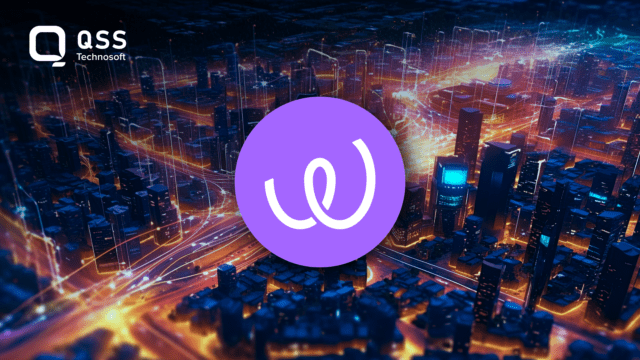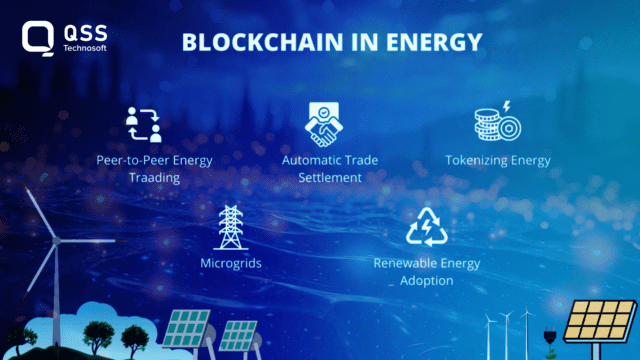We all are familiar with the reality that the power region debts for almost thirds of global greenhouse gasoline emissions. This has sparked a developing name for a sustainable and decentralized strength machine, which has led us to the upward thrust of blockchain-primarily based energy answers.
To make this clear, let me share one study with you. According to a report by Straits Research, The global blockchain in energy market size was valued at USD 7.05 billion in 2023. It is estimated to reach USD 1,285.25 billion by 2032, growing at a CAGR of 78.32% during the forecast period (2024–2032).
One instance of a blockchain-based solution transforming the power region is the Brooklyn Microgrid, which lets nearby residents shop for and promote greater solar energy generated from their own rooftops. This decentralized and peer-to-peer energy marketplace reduces reliance on centralized utilities and promotes renewable power usage.
With blockchain’s capability to supply transparency, safety, and efficiency to the strength area, it’s far no marvel that it’s disrupting the industry and paving the way for a greater sustainable destiny.
In this blog, we will explore how blockchain is disrupting the energy sector, the benefits it brings, and some real-world use cases.
Read Also : Blockchain development Security: Is It Safe to Use Distributed Ledger Technology?
Understanding Blockchain Disrupting in the Energy Sector
To understand how blockchain is disrupting the energy sector, we need to first understand the traditional energy system.
The energy sector has traditionally relied on centralized systems, where energy is generated by a few large power plants and distributed through a network of transmission and distribution lines. This centralized model has its limitations, including inefficiencies, lack of transparency, and vulnerability to cyber-attacks.
Blockchain technology, on the other hand, offers a decentralized and transparent approach to energy management. It enables peer-to-peer transactions, where energy can be exchanged directly between producers and consumers, without the need for intermediaries. This not only reduces costs but also increases the efficiency and reliability of the energy system.
One example of the application of blockchain in the energy sector is the EWF (Energy Web Foundation), which is a non-profit organization dedicated to unleashing the potential of blockchain in the energy sector.

- The EWF has established a blockchain platform that enables the tracking of renewable energy certificates (RECs) from generation to consumption.
- The use of blockchain technology in energy systems is still in its early stages, but with its growing potential, it can be expected to play a transformative role in the coming years.
Read Our Guide : Your Guide to Develop Blockchain Wallet Apps
Benefits of Blockchain Disrupting the Energy Sector
Blockchain technology has the potential to revolutionize various industries, and the energy sector is no exception. The distributed ledger system offers several benefits that can enhance the efficiency, transparency, and security of energy transactions.

Let’s explore how blockchain is disrupting the energy sector and the numerous benefits it brings.
Decentralization and Peer-to-Peer Energy Trading:
Blockchain enables the creation of decentralized energy grids where individuals can produce, store, and sell electricity directly to others without the involvement of intermediaries.
By enabling peer-to-peer energy trading, blockchain reduces dependency on traditional energy providers, promotes renewable energy adoption, and lowers costs for consumers.
For example, companies like Power Ledger and LO3 Energy are using blockchain to facilitate peer-to-peer energy trading between households, reducing reliance on centralized power systems.
Improved Energy Market Efficiency and Transparency:
The use of blockchain technology in energy markets improves transparency and reduces the need for manual verification, making the entire process more efficient.
Smart contracts, powered by blockchain, automate and enforce the terms of energy transactions without the need for intermediaries. This eliminates the risk of fraud, reduces administrative costs, and ensures faster settlements.
Companies like WePower and Grid+ are utilizing blockchain to create efficient energy markets that optimize energy distribution and pricing.
Enhanced Grid Management and Renewable Energy Integration:
Blockchain can provide better grid management and integration of renewable energy sources. By recording and verifying energy production and consumption data in real time, blockchain enables more accurate forecasting and load balancing, leading to reduced wastage and increased efficiency in energy distribution.
Siemens is developing a blockchain-based solution to integrate small-scale renewable energy sources into the grid, ensuring smooth and efficient energy flow.
Energy Data Management and Security:
Blockchain can securely store and manage energy data, ensuring its integrity and preventing unauthorized access. Energy providers can securely record and share customer data, meter readings, and consumption patterns on the blockchain, providing consumers with the ability to control and monetize their energy data.
LO3 Energy’s blockchain-based system allows consumers to securely sell their energy consumption data to third-party companies for research and analysis purposes, ensuring data privacy and security.
Read Also: How AI and Blockchain Are Reshaping the Insurance Sector?
Use Cases of Blockchain Disrupting the Energy Sector
Let’s explore some of the prominent use cases of blockchain in disrupting the energy sector:
Peer-to-Peer (P2P) Energy Trading:
Blockchain enables direct P2P trading of surplus energy between consumers, bypassing the need for intermediaries. An example of this is the Brooklyn Microgrid project in New York, where residents with solar panels can trade excess energy with their neighbors using a blockchain-based platform.
Energy Grid Management:
Blockchain can optimize grid management by providing a real-time and transparent view of energy supply and demand. It enables secure and automated communication between various entities involved, such as power plants, consumers, and grid operators. LO3 Energy’s Exergy platform, based on blockchain, manages energy flows in microgrids, ensuring efficient utilization of renewable sources.
Decentralized Energy Systems:
Renewable energy generation from sources like solar panels can be integrated into blockchain-based decentralized systems. These systems facilitate the exchange of renewable energy certificates, ensuring transparent tracking of green energy production and consumption. Power Ledger, an Australian company, utilizes blockchain for peer-to-peer trading of solar energy within communities.
Energy Supply Chain Management:
Blockchain can enhance supply chain transparency by enabling secure tracking and verification of sustainable energy sources. By recording energy production, transmission, and distribution on the blockchain, it becomes easier to incentivize and verify renewable energy generation. Energy Web Foundation’s Origin platform utilizes blockchain to certify the origin and sustainability of energy sources.
Electric Vehicle (EV) Charging:
Blockchain can simplify and secure transactions and data sharing between EVs, charging infrastructure, and electricity providers. It enables automated payments, grid balancing, and decentralized charging infrastructure management. Share&Charge, a blockchain-based platform, allows EV owners to share their charging stations and get paid automatically.
Challenges
While blockchain technology holds immense promise for the energy sector, there are some challenges that need to be overcome:
- Scalability: Blockchain networks like Bitcoin and Ethereum currently face scalability issues, limiting the number of transactions they can handle per second. This poses a challenge for scaling up blockchain solutions in the energy sector.
- Regulatory and Policy Frameworks: The deployment of blockchain in the energy sector requires the development of supportive regulatory and policy frameworks that address issues such as data privacy, cybersecurity, and interoperability.
- Integration with Existing Systems: Integrating blockchain solutions with existing energy infrastructure can be complex and requires collaboration between different stakeholders.
Read Also: Blockchain development for Gaming Apps: A New Era of Play-to-Earn Opportunities
Future Outlook
The future of blockchain in the energy sector looks promising.
Blockchain technology has the potential to revolutionize the energy sector by reducing costs, improving efficiency, and increasing transparency. According to a report by the World Energy Council, the deployment of blockchain technology in the energy sector is expected to reach $3.7 billion by 2025.
One of the most promising applications of blockchain in the energy sector is peer-to-peer (P2P) energy trading. This allows consumers to directly buy and sell energy to each other, eliminating the need for intermediaries and reducing costs. Platforms like Power Ledger and WePower are already enabling P2P energy trading in some parts of the world.
The implementation of blockchain technology in the energy sector is still in its early stages, but the potential benefits are clear. As the technology continues to develop and more use cases are discovered, we can expect to see even greater adoption in the years to come.
Transforming the Energy Landscape: QSS Technosoft’s Disruptive Blockchain Solutions in the Energy Sector
QSS Technosoft is at the forefront of providing blockchain solutions to revolutionize how energy is generated, distributed, and consumed.
By implementing blockchain technology in the energy sector, QSS Technosoft offers the following benefits:
- Energy communities: With blockchain, QSS Technosoft enables the creation of decentralized energy communities where individuals and businesses can generate, store, and share energy within a localized network. This decentralized model promotes energy independence and resilience, reducing reliance on centralized energy providers.
- Incentivizing energy conservation: QSS Technosoft’s blockchain solutions can incentivize energy conservation by tracking and rewarding users for reducing their energy consumption. By implementing smart meters and blockchain-based reward systems, energy consumers are motivated to adopt energy-efficient practices, resulting in a more sustainable energy ecosystem.
- Carbon footprint reduction: Blockchain technology can be used to measure and track the carbon footprint of energy generation and consumption. QSS Technosoft’s blockchain solutions enable accurate carbon footprint calculations, creating a transparent system where renewable energy sources and energy-efficient practices are incentivized, further driving the transition to a low-carbon future.
- Microgrids and energy sharing: QSS Technosoft use blockchain to facilitate the creation of microgrids, small-scale energy networks that can operate independently or as part of a larger grid. This enables communities to share excess energy generated from renewable sources and promotes local energy resilience.
- Energy data management: Blockchain technology provides a secure and immutable platform for managing energy data. QSS Technosoft’s blockchain solutions ensure that energy data collected from various sources, such as smart meters and IoT devices, is securely stored, shared, and analyzed, enabling more accurate energy forecasting and efficient grid management.
Conclusion
Blockchain technology is making big changes in the energy industry. It can help us manage energy in a decentralized and transparent way, which saves money, makes things work better, and keeps everything safe. We can do cool things like trading energy directly with each other and tracking where our energy comes from.
But there are still some problems we need to figure out, like making it work for lots of people and following the rules. But if we keep working together, the future of blockchain in energy looks really bright. So let’s get started and make our energy better with blockchain!
We are proud to mention that our work has been recognized by leading B2B reviews and research platforms like GoodFirms, Clutch, MirrorView, and many more.


How is Blockchain Disrupting the Energy Sector? Benefits and Use Cases